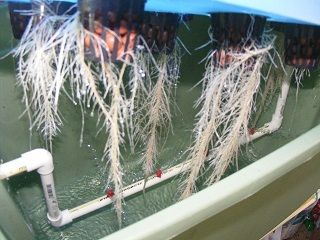Aquaponics, Aeroponics, and Other Concepts in Modern Vegetable Farming

I believe that the future will rely on vertical urban farming – and most of the farms across the Midwest will have to be glassed in over the next hundred years. But I think that the true gains here won’t be found without massive integration of technologies and demand.
The efforts that would be required to move forward here would never be palatable for a standard investor. Far too much capital would be required at an unproven model, and a small-scale model would have too many inefficiencies and too poor a ROI to attract bigger investors. (emphasis mine)
First, let’s take a few steps back. Aeroponics defines a class of closely related technologies in which vegetables are grown, not in the ground, but in some sort of arrangements by which the roots are fed and moistened by a mist of water and nutrients in a system like that shown above. While at first blush, such a system appears space-age, it provides a staggering number of benefits as compared by today’s agribusiness:
• A tiny fraction of water is required to grow an equivalent amout of produce.
• There are no issues with soil depletion, whether from monocropping, or from increasingly powerful chemical insecticides, herbicides, and fertilizers that are needed to counteract the man-made decline in soil productivity.
• All produce is grown locally, often literally within walking distance of its place of consumption. This eliminates the need for diesel trucking; the average bit of food Americans eat travelled 1200 miles to get to our supermarkets.
• Correspondingly, the process also provides a far fresher product to the consumer; produce does not have to be harvested before it had the chance to ripen naturally, and then come to maturity while in transit.
• In terms of land-use, hundreds of times more food can be grown per acre than in conventional farming.
• Solutions like these have the potential to bring an end to “food deserts” in the inner cities, where conditions are so miserable and dangerous that supermarket executives are unwilling to set up shop.
• The costs of these solutions can be fantastically small, as they consist of only a plastic tube, a low-power motor that runs a few minutes per hour, and, if housed away from the sun, LED lighting that provides only the narrow bands of light frequencies that the plants require.
As hard as it may be to believe, plants grow better and stronger under these conditions than they do in dirt.
Now, let’s realize that what Mr. Doty says here is true, i.e., we’re a very long way from glassing in huge farms; (I don’t really see that happening in any case). He’s also right that investors who jump right into this with both feet without thinking through exactly where the subject is going are bound to lose their money.
But let’s look at this: Right now, there are restaurants in Manhattan whose sole source of vegetables for their patrons is growing on the roofs of their buildings. There are no trucks bringing in the fanciest and rarest cultivars of endive and arugula coming into The City from..wherever…to their door every day; the chef walks up a flight of stairs, opens a door, walks out onto his roof, and harvests what he needs—a few minutes before it will be used in his kitchen.
The same is true of high-end grocery stores specializing in organic foods.
All over the country, philanthropic organizations whose missions are improving conditions for those living in the crushing poverty and despair of our country’s most troubled inner city environments are looking for solutions like this: nutritious, community-grown food, grown in tiny areas whose horrible soil quality is irrelevant.
My point: aeroponics has a significant market today—one that will only grow as the years go by.
Yes, project developers who say, “I want $30 million of other people’s money to build a huge aeroponics plant somewhere..anywhere,” are receiving the scorn they rightfully deserve. But, like anything else, that doesn’t invalidate the entire concept.

Craig,
It doesn’t invalidate the entire process… but it does put things into perspective. Upscale restaurants and organic grocers for foodies are one thing. But to analyze where this must eventually end up, and try to find a path from the rooftops of high-end restaurants to large-scale operations that could feed a modest percentage of the human species… There are chasms to cross.
That’s going to take someone climbing down and back up the other side – and pulling a rope across. In my opinion that will be the first massively integrated platform which has – as a waste product – fertilizer, clean CO2, water, and waste heat.
It will eventually happen because it must, and once all options start running dry someone is going to throw the Hail Mary.
*shrug*
Until then, this is just a high-end and novel form of gardening.
I am interested in aeroponics. please help me with materials and fellowship opportunity to acquire practical experience. Am a Ph.D student in Agricultural Education department, University of Nigeria, Nsukka working on “Exploring the potentials of aeroponics in implementing secondary school agricultural programme in urban cities in Nigeria”. Thanks
Sorry, but I have nothing to offer you. My connection with this aeroponics company has fizzled.
Best of luck to you in all your endeavors.